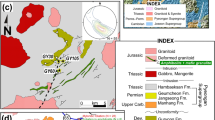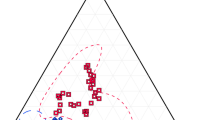Abstract
Mineral equilibria modeling involving solid solution calculations has been combined with mineral assemblage information from the alteration zones associated with gold mineralization to determine the T and X CO2 conditions for the formation of the Magdala gold deposit at Stawell, Victoria, Australia. Economic gold mineralization is primarily hosted within the stilpnomelane alteration zone of the Stawell Facies that is adjacent to the Magdala Basalt. Evolution of the Magdala gold deposit involved at least three fluid infiltration events: (1) a CO2-bearing fluid during the D2 deformation event produced carbonate spots throughout the chlorite zone; (2) a CO2–S–K-bearing fluid, accompanied the D3–4ab deformation and produced a muscovite zone and siderite rims on ankerite; and (3) a CO2–K–S–Au-bearing fluid during the D4c deformation event produced the stilpnomelane zone of the Stawell Facies, the proximal and distal alteration zones within the Magdala Basalt, and the main economic gold mineralization. Mineral equilibria modeling constrains the temperature of formation of the Magdala deposit to T = 345–390°C at 3kbar, substantially lower than indicated by other previous classical thermobarometry methods. Furthermore, this method has allowed the characterization of the mineralizing fluid and constrained its composition to X CO2 < 0.08 at 3kbar. The timing and composition of the mineralizing fluids are similar to that of metamorphic fluid generated from devolatilization of a greenstone pile with peak of metamorphism occurring earlier and at deeper levels in the crust.









Similar content being viewed by others
References
Baker J, Holland T, Powell R (1991) Isograds in internally buffered systems without solid solutions: principles and examples. Contrib Mineral Petrol 106:170–182
Baumgartner LP, Ferry JM (1991) A model for coupled fluid-flow and mixed volatile mineral reactions with applications to regional metamorphism. Contrib Mineral Petrol 106:273–285
Bickle MJ, Baker J (1990) Advective diffusive transport of isotopic fronts—an example from Naxos, Greece. Earth Planet Sci Lett 97:78–93
Bierlein FP, Arne DC, Mcknight S, Lu J, Reeves S, Besanko J, Marek J, Cooke D (2000a) Wall-rock petrology and geochemistry in alteration halos associated with mesothermal gold mineralization, Central Victoria, Australia. Econ Geol 95:283–312
Bierlein FP, Arne DC, McKnight S, Lu J, Reeves S, Besanko J, Marek J, Cooke F (2000b) Wallrock petrology and geochemistry in alteration halos associated with mesothermal gold mineralization, Central Victoria, Australia. Econ Geol 95:283–312
Brown EH (1967) The greenschist facies in part of eastern Otago, New Zealand. Contrib Mineral Petrol 14:259–292
Coggon R, Holland TJB (1992) Mixing properties of phengitic micas and revised garnet-phengite thermobarometers. J Metamorph Geol 20:683–696
Cox SR, Sun SS, Etheridge MA, Wall VJ, Potter TF (1995) Structural and geochemical controls on the development of turbidite-hosted gold deposits, Wattle Gully Mine, central Victoria Australia. Econ Geol 90:1722–1746
Cui X, Nabelek PI, Liu M (2003) Reactive flow of mixed CO2–H2O fluid and progress of calc-silicate reactions in contact metamorphic aureoles: insights from two-dimensional numerical modeling. J Metamorph Geol 21:663–684
Dale J, Powell R, White RW, Elmer FL, Holland T (2005) A thermodynamic model for Ca–Na clinoamphiboles in NCFMASHO. J Metamorph Geol 23:771–791
Dugdale A, Hagemann S (2001) The Bronzewing lode–gold deposit, Western Australia: P–T–X evidence for fluid immiscibility caused by cyclic decompression in gold-bearing quartz-veins. Chem Geol 173:59–90
Dugdale A, Wilson CJL, Squire RJ (2006) Hydrothermal alteration at the Magdala gold deposit, western Victoria. Aust J Earth Sci 53:733–757
Elmer FL (2004) Mineral equilibria in low-grade carbonate-bearing rocks. Ph.D. thesis, The University of Melbourne, pp 1–266
Elmer FL, White RW, Powell R (2006) Devolatilisation of metabasic rocks during greenschist-amphibolite Facies metamorphism. J Metamorph Geol 24:497–513
Evans KA, Bickle MJ (1999) Determination of time-integrated metamorphic fluid fluxes from the reaction progress of multivariant assemblages. Contrib Mineral Petrol 134:277–293
Evans KA, Powell R (2006) A method for activity calculations in saline and mixed solvent solutions at elevated temperature and pressure: a framework for geological phase equilibria calcuations. Geochim Cosmochim Acta 70:5488–5506
Ferry J, Wing BA, Penniston-Dorland SC, Rumble IIID (2002) The direction of fluid flow during contact metamorphism of siliceous carbonate rocks: new data for the Monzoni and Predazzo aureoles, northern Italy, and a global review. Contrib Mineral Petrol 142:679–699
Foster DA, Gray DR, Kwak TAP, Bucher M (1998) Chronology and tectonic framework of turbidite-hosted gold deposits in the western Lachlan Fold Belt, Victoria: 40Ar–39Ar results. Ore Geol Rev 13:229–250
Gray DR, Gregory RT, Durney DW (1991) Rock-buffered fluid-rock interaction in deformed quartz-rich turbidite sequences, Eastern Australia. J Geophys Res 96:19681–19704
Greenwood H (1975) Buffering of pore fluids by metamorphic reactions. Am J Sci 275:573–594
Holland T, Powell R (1990) An internally consistent thermodynamic data set with uncertainties and correlations: the system K2O–Na2O–CaO–MgO–MnO–FeO–Fe2O3–Al2O3–TiO2–SiO2–CO2–H2O. J Metamorph Geol 8:89–124
Holland T, Powell R (1992) Plagiocalse feldspars: activity–composition relations based on Darken’s quadratic formalism and Landau theory. Am Mineral 77:53–61
Labotka T, Anovitz L, Blencoe J (2002) Pore pressure during metamorphism of carbonate rock: effect of volumetric properties of H2O–CO2 mixtures. Contrib Mineral Petrol 144:305–313
Mapani BES, Wilson CJL (1998) Evidence for externally derived vein forming and mineralising fluids: an example from the Magdala gold mine, Stawell, Victoria, Australia. Ore Geol Rev 13:323–343
Miller JMCL, Wilson CJL (2002) The Magdala lode deposit, Stawell, south eastern Australia: structural style and relationship to gold mineralization across the western Lachlan fold belt. Econ Geol 97:325–349
Miller JMCL, Wilson CJL (2004) Structural analysis of faults related to a heterogeneous stress history: reconstruction of a dismembered gold deposit, Stawell, western Lachlan Fold Belt, Australia. J Struct Geol 26:1231–1256
Miller JMCL, Phillips D, Wilson CJL, Dugdale LJ (2005) Evolution of a reworked orogenic zone: the boundary between the Delamerian and Lachlan, Fold Belts, southeastern Australia. Aust J Earth Sci 52:921–940
Miller JMCL, Wilson CJL, Dugdale LJ (2006) The Stawell gold deposit: a key to unravelling the Cambrian to Early Devonian structural evolution of the western Victorian goldfields. Aust J Earth Sci 53:677–695
Miyano T, Klein C (1989) Phase equilibria in the system K2O–FeO–MgO–Al2O3–SiO2–H2O–CO2 and the stability limit of stilpnomelane in metamorphosed Precambrian iron formations. Contrib Mineral Petrol 102:478–491
Murphy FC, Rawling TJ, Wilson CJL, Dugdale LJ, Miller JMCL (2006) 3D structural modelling and implications for targeting gold mineralisation in western Victoria. Aust J Earth Sci 53:875–889
Neall FB, Phillips GN (1987) Fluid-wall rock interaction in an Archean hydrothermal gold deposit: a thermodynamic model for the Hunt mine, Kambalda. Econ Geol 82:1679–1694
Offler R, McKnight S, Morand V (1998) Tectnothermal history of the western Lachlan Fold Belt, Australia: insights from white mica studies. J Metamorph Geol 16:531–540
Pitcairn IK, Teagle DAH, Olivio GR, Kerrich R, Brewer TS (2006) Sources of metals and fluids in orogenic gold deposits: insights from the Otago and Alpine schists, New Zealand. Econ Geol 101:1525–1546
Phillips GN, Brown IJ (1987) Host rock and fluid control on carbonate assemblages in the Golden Mile Dolerite, Kalgoorlie gold deposit, Australia. Can Mineral 25:265–273
Phillips GN, Hughes MJ (1996) The geology and gold deposits of the Victorian gold province. Ore Geol Rev 11:255–302
Potel S, Schmidt ST, de Capitani C (2002) Composition of pumpellyite, epidote and chlorite from New Caledonia, how important are metamorphic grade and whole-rock composition. Schweiz Mineral Petrogr Mitt 82:229–252
Powell R, Holland T (1988) An internally consistent thermodynamic dataset with uncertainties and correlations: 3. Application, method, worked examples and a computer program. J Metamorph Geol 6:173–204
Powell R, Holland T (1999) Relating formulations of the thermodynamics of mineral solid solutions: activity modeling of pyroxenes, amphiboles and micas. Am Mineral 84:1–14
Powell R, Holland T, Worley B (1998) Calculating phase diagrams involving solid solutions via non-linear equations, with examples using THERMOCALC. J Metamorph Geol 16:577–588
Schaubs PM, Zhao C (2002) Numerical models of gold-deposit formation in the Bendigo–Ballarat zone, Victoria. Aust J Earth Sci 49:1077–1095
Squire RJ, Wilson CJL (2005) Interaction between collisional orogenesis and convergent-margin processes: evolution of the Cambrian proto-Pacific margin of East Gondwana. J Geol Soc 162:749–761
Skelton ADL, Graham CM, Bickle JM (1995) Lithological and structural controls on regional 3-D fluid flow patterns during greenschist Facies metamorphism of the Dalradian of the SW Scottish Highlands. J Petrol 36:563–586
White RW, Powell R, Phillips GN (2003) A mineral equilibria study of the hydrothermal alteration in mafic greenschist Facies rocks at Kalgoorlie, Western Australia. J Metamorph Geol 21:455–468
Wilson CJL, Will TM, Cayley RA, Chen S (1992) Geologic framework, tectonic evolution in western Victoria, Australia. Tectonophysics 214:93–127
Acknowledgements
This project was funded by Leviathan Resources and the Predictive Mineral Discovery Cooperative Research Centre. The authors wish to thank Leviathan Resources for allowing the publication of this paper before the expiry of the confidentiality agreement. We would like to thank Roger Powell, Richard White, and John Miller for the discussions and comments and Noel White, two anonymous referees, Thomas Wagner, and Larry Meinert for the editorial comments.
Author information
Authors and Affiliations
Corresponding author
Additional information
Editorial handling: N. White
Appendix
Appendix
Fe–Mg stilpnomelane
Generation of a thermodynamic model for stilpnomelane is difficult due to the lack of thermodynamic or experimental data and uncertainties in its formula. The assumed formula for stilpnomelane is \({\text{K}}_{1.26} {\text{Mg}}_{6.02}^{2 + } {\text{Fe}}_{6.02}^{2 + } {\text{Al}}_{2.26} {\text{Si}}_{15.8} {\text{O}}_{38.64} \left( {{\text{OH}}} \right)_{18.04} \). Fe–Mg mixing occurs on one octahedral site. With uncertainties on the thermodynamic properties of both end-members involved in the binary Fe–Mg stilpnomelane model, the thermodynamic properties of other end-members are combined in the correct proportions, as shown below. The enthalpies of formation of both end-members were then adjusted so that the (1) Fe–Mg partition between stilpnomelane and pumpellyite is appropriate (Potel et al. 2002) and so chlorite + K-feldspar = biotite + stilpnomelane reactions occur at temperatures a little lower that the disappearance of actinolite + biotite, in agreement with field observations (Brown 1967).
For binary Fe–Mg stilpnomelane, there is one compositional variable:
The resulting individual site fractions are:
For binary, single-site mixing stilpnomelane, end-member proportions are equivalent to the corresponding site fractions:
With a multiplicity of 6, the ideal activity expressions are:
The resulting data file looks like:
%==================================
sti 2
%———————————————————————————————
%———————————————————————————————
ideal
%———————————————————————————————
%———————————————————————————————
%==================================
Rights and permissions
About this article
Cite this article
Elmer, F.L., Dugdale, A.L. & Wilson, C.J.L. Application of mineral equilibria modeling to constrain T and X CO2 conditions during the evolution of the Magdala gold deposit, Stawell, Victoria, Australia. Miner Deposita 43, 759–776 (2008). https://doi.org/10.1007/s00126-008-0192-4
Received:
Accepted:
Published:
Issue Date:
DOI: https://doi.org/10.1007/s00126-008-0192-4




